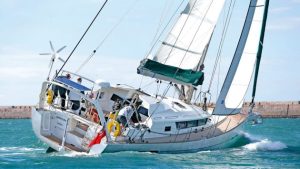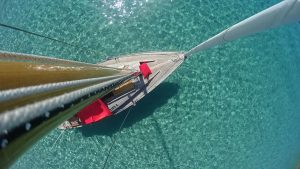Navigating a beat to windward is a fundamental sailing skill that involves sailing as close to the wind as possible in a zigzag pattern to reach an upwind destination. This technique requires precise sail trim, careful steering, and strategic planning to maximize your boat’s performance and efficiency.
To begin, ensure your sails are properly trimmed. The mainsail and jib should be hauled in tight, with the telltales streaming straight back to indicate optimal airflow. Your boat should be heeled slightly, which helps to reduce drag and improve speed. Keep a close eye on the wind direction, using a wind vane or telltales on the shrouds, and adjust your sails and course accordingly to maintain the best angle of attack.
When sailing upwind, you will need to tack, or change direction, frequently to make progress. Plan your tacks carefully to avoid obstacles and take advantage of wind shifts. Each tack should be executed smoothly: turn the boat through the wind, shift the sails to the opposite side, and settle onto the new course. Maintain a consistent speed by balancing the boat and adjusting the sails as needed.
Understanding the Basics of Beating
Beating, or sailing against the wind, is a technique that requires sailing your vessel in a zigzag pattern to make forward progress towards your upwind destination. As you alternate between tacking angles, you harness as much forward momentum as possible, working within the limitations imposed by wind direction and sail technology.
Theoretical Concepts Behind Beating
Two essential concepts underlie the technique of beating: the apparent wind and the sailboat’s ability to sail at an angle to the true wind. The interplay of these variables determines the effectiveness and efficiency of your maneuvers. The apparent wind is a combination of the true wind and the wind generated by the boat’s movement. Understanding how this affects sail dynamics is critical to fine-tuning your approach.
The terms “lift” and “drag,” borrowed from aerodynamics, are equally crucial in this context. Just as an airplane wing generates lift as it moves through the air, so too do sails create lift as they slice through the wind. Similarly, drag is the resistance the sail faces from the wind. Maximizing lift and minimizing drag are key components in the art of beating.
Anatomical Elements of a Sailboat
To effectively execute beating maneuvers, it is imperative to understand the main parts of a sailboat: the hull, keel, rudder, and sails. The hull is the body of the boat, while the keel is a flat blade that protrudes beneath the ship, providing stability and preventing sideways drift. The rudder is pivotal for steering, and the sails are your primary propulsion device, capturing the wind to move the vessel.
Each component plays a symbiotic role in the act of sailing. The interaction between the keel and sails assists in counterbalancing lateral forces, allowing for directional control even when pointed into the wind.

Techniques to Optimize Beating
Navigating against the wind isn’t just about brute force; it’s an art that involves strategy and precision. Here are several techniques that can help refine your approach:
Tacking: The Core Movement
Tacking involves changing the boat’s direction by turning the bow through the wind. Proper timing and execution of this maneuver are crucial to maintain momentum and avoid stalls. As you tack, maintaining boat speed and angle of attack ensures that you transition smoothly through the wind’s eye, repositioning your sails to optimize lift.
Understanding the No-Go Zone
The no-go zone refers to an angle range, typically between 30 to 45 degrees from directly into the wind, where sailing is inefficient or impossible. Proper management of the no-go zone is essential for effective beating, requiring you to stay just outside its limits to maintain steady progress.
Sail Trim and Adjustments
Trimming your sails means adjusting them for optimal wind capture. A well-trimmed sail captures the maximum amount of wind energy, while poor adjustments can lead to excessive heeling or inefficiency. Regularly adjusting the tension and position of sails as wind conditions change is vital for fine-tuning your approach.
| Adjustment | Purpose |
|---|---|
| Tighten Sheets | Decrease drag and improve angle of attack |
| Ease Sheets | Reduce pressure and balance the boat |
| Adjust Outhaul | Flatten or deepen the sail for efficiency |
Using Tell Tales
Tell tales are small ribbons attached to the sails that provide visual signals for airflow. Observing these indicators helps ensure that your sails are trimmed correctly and indicates any necessary adjustments to improve sail angle relative to the wind.
Balancing Boat Heel
Heel refers to the angle of tilt in the boat caused by wind pressure on the sails. Although a certain degree of heel is normal, excessive heeling can reduce speed and control. Balancing the heel using crew weight distribution or sail adjustments can significantly enhance performance.

Environmental Factors Affecting Beating
Besides understanding your vessel, being attuned to environmental elements such as wind shifts and current patterns can influence your beating strategy significantly.
Navigating Wind Shifts
Wind shifts can either present opportunities or challenges while beating. A favorable shift might allow for a more direct course, while unfavorable shifts may necessitate an adjustment in your beating pattern. Staying vigilant and responsive to shifting winds is integral to effective navigation.
Current and Tidal Influences
Currents and tides can affect boat speed and direction, either aiding or impeding progress. It’s crucial to account for these factors in your sailing plan, adjusting your course and tactics as needed to leverage or counteract these forces.
Advanced Tactics for Experienced Helmsmen
Once you’ve mastered the fundamentals, more sophisticated tactics can further enhance your capability in challenging conditions.
Implementing Tactical Tacks
Advanced tacking involves strategic planning of each turn, considering upcoming wind shifts and obstacles. Properly executed, tactical tacks can exploit wind changes to your advantage, maximizing speed and efficiency.
Pinching and Footing
Pinching involves sailing as close to the wind as possible, maximizing your upwind progress. However, pinching can lead to decreased speed and power if not executed carefully. Conversely, footing involves sailing slightly further from the wind for increased speed, potentially sacrificing some upwind angle. Balancing these approaches allows you to respond dynamically to conditions.
Navigating Obstacles and Traffic
When dealing with obstacles or other vessels, anticipation and foresight become critical. Planning ahead reduces risks and ensures smoother transitions, allowing you to maintain momentum and course goals.
Conclusion: Mastering the Art of Beating
Ultimately, successful beating requires both technical prowess and insightful decision-making. By combining foundational knowledge with an adaptive approach to wind and environmental factors, you position yourself to make the most of your sailing experience. Practice and attentiveness will transform you into a helmsman capable of facing the headwinds with confidence and competence.
The knowledge gleaned through this exploration of beating is merely the starting point. Harnessing these techniques will empower you to continue your nautical journey, refining your craft and venturing into new challenges with assuredness and poise.





